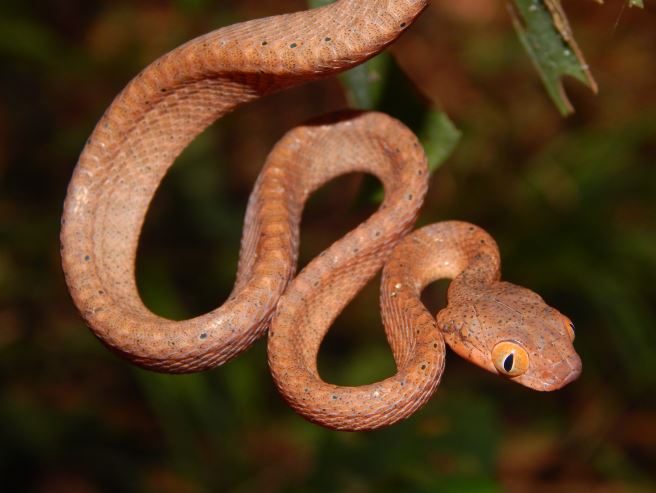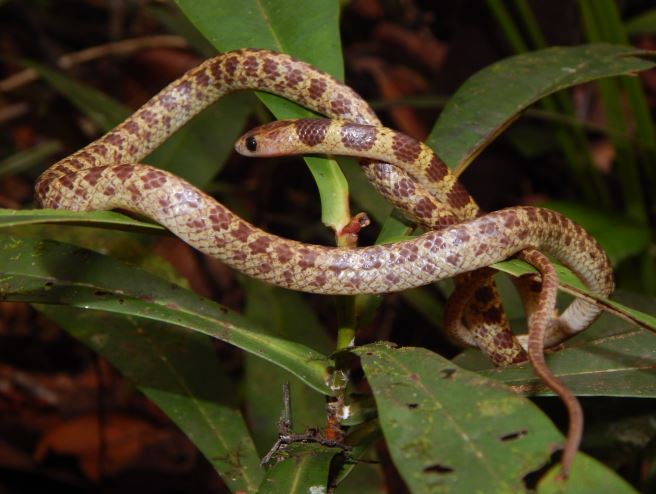June 02, 2025
Snakes are among the most misunderstood animals on the planet. Often feared, sometimes admired, they play a vital role in ecosystems by controlling rodent populations and maintaining a natural balance in food chains. In the forest of the Restorasi Ekosistem Riau (RER) project, snakes are essential to the health of peat swamp ecosystems, contributing to biodiversity and acting as both predator and prey.
As part of RER’s ongoing conservation efforts on the Kampar Peninsula, understanding the role of snakes—and how to safely identify them—has become increasingly important. Many people want to know the difference between venomous snakesand non-venomous snakes, often for reasons of safety. But the truth is, telling them apart is more complicated than most of us realize.
In this article, we debunk a few of the most common myths related to snake identification, while also looking into snake behavior and profiling a few of the species found on the Kampar Peninsula.

Debunking Common Snake Identification Myths
You’ve probably heard a few so-called “rules” for identifying dangerous snakes in the wild. While some general trends exist, they’re not reliable enough to trust in a real-life situation. Here are some of the most common myths about snakes—and the truth behind them.
Myth 1: If it has a triangular head, it’s venomous
This is one of the most widespread beliefs, but it’s misleading. While some venomous snakes do have wider heads, others do not. For example, the Javan cobra (Naja sputatrix) and the Malayan coral snake (Calliophis intestinalis) both have fairly rounded heads, yet are highly venomous. Meanwhile, many non-venomous snakes flatten their heads when threatened to appear more dangerous than they really are.
Myth 2: Slit pupils mean the snake is venomous
This is another oversimplification. Some non-venomous snakes have vertical pupils, while others don’t. Take the Sunda king cobra (Ophiophagus bungarus)—a powerful, venomous species with round pupils. The differences between venomous and non-venomous snakes can’t be reduced to eye shape.
Myth 3: Bright colors signal venom
It’s true that some venomous species use vivid colors as a warning, but not always. The Malayan pit viper (Calloselasma rhodostoma), for example, is venomous but incredibly well camouflaged in leaf litter. Conversely, non-venomous snakes may adopt bold coloring to mimic venomous species as a form of defense.
Behavior Doesn’t Tell the Whole Story
Another common mistake is assuming that snake behavior is a clue to danger level. While some people believe aggressive snakes are venomous or that calm ones are not, this doesn’t hold up under scrutiny.
Take the red-tailed rat snake (Gonyosoma oxycephalum). It’s non-venomous but can be a bold ambush predator. On the flip side, some highly venomous snakes avoid confrontation entirely. Even mimicry can mislead: the copperhead racer (Coelognathus radiatus), though harmless, imitates the defensive behavior of more dangerous snakes.

Inside the Mouth: Snake Dentition Explained
If you’re a trained herpetologist, one of the more technical ways to tell poisonous and non-poisonous snakes’ difference lies in their dentition—or tooth structure.
Non-venomous snakes generally fall under the Aglyphous category, meaning they have no specialized fangs. Examples include pythons and rat snakes. Venomous species, however, may fall under one of three other types:
But identifying these traits requires close examination, which is not only impractical in the field but also extremely dangerous. For most people, it’s safer to admire wildlife snakes from a distance.
Read also: Take a Closer Look at the Sumatran Cobra
Why Field Identification Is So Risky
Despite the wealth of information available, there is no quick or safe way to identify a snake in the wild without expert training. Many species look similar or have evolved deceptive traits. Attempting to handle a snake—or even getting too close—can result in unnecessary risk.
The safest approach is simple: if you see a snake, don’t panic. Keep a respectful distance, don’t attempt to move or kill it, and contact local wildlife experts if necessary. In areas like the Kampar Peninsula, RER’s wildlife teams are trained to respond when needed.
Snake Diversity in the Kampar Peninsula
RER’s 2023 biodiversity survey added new insights into the region’s remarkable reptile population. The peat swamp forests provide an ideal habitat for snakes, supporting both venomous and non-venomous species.
Here are a few standout species from recent surveys:
These examples highlight just how varied—and fascinating—the snake population is in RER. Each species has its own place in the ecosystem, helping maintain the delicate balance of prey and predator that sustains the forest.
A Call for Awareness, Not Fear
Snakes have long been the subject of myths and fears, but science tells a different story. They are essential components of healthy ecosystems, controlling populations of rodents and insects while serving as prey for larger animals.
By shifting our mindset from fear to understanding, we can better appreciate the vital role snakes play—not just in RER’s forests, but in ecosystems around the world. Respecting their space and learning the facts about snake myths and facts is a step toward smarter, safer conservation.
Learn More
To learn more about the snake species found in the Kampar Peninsula, and to find out how RER is working to protect them, check out our latest herpetofauna survey and 10-year progress report.
Snakes aren’t just survivors—they’re ecosystem stewards. And in RER’s forest, they’re right where they belong.